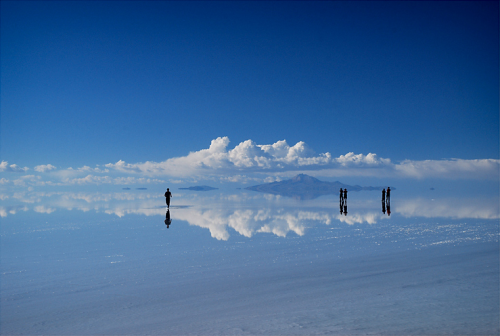A little mid-day wisdom from Rick Hanson.
Step Into The Cloud
Rick Hanson, Ph.D. - Neuropsychologist and author of Just One Thing: Developing a Buddha Brain One Simple Practice at a Time
I had a lightbulb moment recently: I was feeling stressed about all the stuff I had to do (you probably know the feeling). After this went on for a while, I stepped back and kind of watched my mind and could see that I was thinking of these various tasks as things, like big rocks that were rolling down a hill toward me and which needed to be handled, lifted, moved, fended off or broken into pebbles. As soon as I dealt with one boulder, another one was rolling toward me. Shades of Sisyphus.
Seen as brick-like entities, no wonder these tasks felt heavy, oppressive, burdensome. Yuck!
But then I realized that in fact the tasks I needed to do were more like clouds than things. Clouds are made up of lots of vaporous little bits, those bits come together for a time due to many swirling causes, and then they swirl away again. Meanwhile, the edge or boundary of a cloud blurs into other clouds or the sky itself. There is a kind of insubstantiality to clouds, and a softness, a yielding.
For example, take writing an email message: It has lots of little parts to it (the points you need to take into account, and the words and sentences), it is nested in a larger context -- your relationship to the receiver, the needs that prompted the email -- that (in a sense) calls it forth, and it emerges and passes away. This email, this task, links to other tasks, sort of blurs into them. Fundamentally, the email is a kind of process, an event, rather than a thing. It's like you could put your hand through it.
When I considered my tasks in this way, I immediately felt better: relieved, relaxed. Tasks felt fluid, like streams or eddies I was stepping into and influencing or contributing to as best I could before they swirled on and became something else. Not so weighty or full of inertia. Not so resistant, so controlling of me. Not bearing down on me, but instead, something I was flowing into. Then I didn't feel weary dealing with them. They became fun, lighter -- there was more freedom in moving through them.
And it's not just tasks that are clouds. In a way, everything is a cloud. Everything is made of parts ("compounded"), everything arises due to causes (so nothing has absolute self-existence -- even "I"), and everything passes away eventually. Everything in your experience and everything "out there" in the universe is a cloud: every sensation, thought, object, body, job, career, activity, relationship, rock, raindrop, planet, galaxy and moment.
This doesn't mean that clouds are meaningless or that they don't have consequences. In fact, when you relate to the world in this way, you feel more connected to it, more a part of it, more tender toward it, and more responsible for it. You love the cloud!
How?
Start by noticing how everything is continually changing: both what's in your inner world of thoughts and feelings and in your outer world of people, tasks and physical stuff. Pay attention to endings and beginnings. And even if something persists, know that this is only temporary. Your own body is a cloud, continually changing.
Also recognize how everything is made up of parts. For example, our reactions have parts (e.g., body sensations, emotions, viewpoints, wants), kitchen tables have parts, relationships have parts (e.g., history, aspects in different situations), and tasks have parts.
Appreciate how these changing parts arise and pass away due to many causes. Everything really is an eddy in the river of reality, emerging and changing and ending because of 10,000 causes upstream.
Try to feel these facts -- impermanence, compoundedness, interdependence -- and the fundamental cloudiness of everything intuitively, emotionally and in your body, not just conceptualize them with your mind.
Then consider a task or situation that weighs on you in this light. Reflect on its many parts, on some of the causes that brought it into being, and on its inherent transience (even if it's a painfully long transience!). Try to see it more as a cloud than a brick.
Notice how your mind tries to turn clouds into bricks. To help us survive, the brain continually tries to make fluid processes (hard for lizards, mice and monkeys to deal with) appear to be static entities (much more manageable). It does this through forming labels, categories and concepts -- and through presuming that everything is a thing in itself rather than only passing frothy foam on a transient wave in our ocean of a universe.
Enjoy the clouds. Relax. Flow into the clouds of your responsibilities, relationships and roles. A cloud yourself, flow into them, through them, beyond them.
For more by Rick Hanson, Ph.D., click here.
For more on mindfulness, click here.
Rick Hanson, Ph.D., is a neuropsychologist and author of the bestselling Buddha's Brain: The Practical Neuroscience of Happiness, Love, and Wisdom (in 20 languages) - and Just One Thing: Developing a Buddha Brain One Simple Practice at a Time. Founder of the Wellspring Institute for Neuroscience and Contemplative Wisdom and Affiliate of the Greater Good Science Center at UC Berkeley, he's taught at Oxford, Stanford, and Harvard, and in meditation centers worldwide. His work has been featured on the BBC, NPR, Consumer Reports Health, and U.S. News and World Report and he has several audio programs. His blog - Just One Thing - has over 30,000 subscribers and suggests a simple practice each week that will bring you more joy, more fulfilling relationships, and more peace of mind and heart. If you wish, you can subscribe to Just One Thing here.

No comments:
Post a Comment